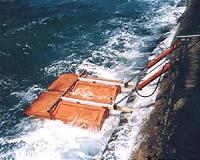 |
Munich, Germany (SPX) Aug 03, 2010 Researchers around the world are working on the development of quantum computers that will be vastly superior to present-day computers. Here, the strong coupling of quantum bits with light quanta plays a pivotal role. Professor Rudolf Gross, a physicist at the Technische Universitaet Muenchen (TUM), and his team of researchers have now realized an extremely strong interaction between light and matter that may represent a first step in this direction. The results of their research are presented in the current online issue of the journal Nature Physics. The interaction between matter and light represents one of the most fundamental processes in physics. Whether a car that heats up like an oven in the summer due to the absorption of light quanta or solar cells that extract electricity from light or light-emitting diodes that convert electricity into light, we encounter the effects of these processes throughout our daily lives. Understanding the interactions between individual light particles - photons - and atoms is crucial for the development of a quantum computer. Physicists from the Technische Universitaet Muenchen (TUM), the Walther-Meissner-Institute for Low Temperature Research of the Bavarian Academy of Sciences (WMI) and the Augsburg University have now, in collaboration with partners from Spain, realized an ultrastrong interaction between microwave photons and the atoms of a nano-structured circuit. The realized interaction is ten times stronger than levels previously achieved for such systems. The simplest system for investigating the interactions between light and matter is a so-called cavity resonator with exactly one light particle and one atom captured inside (cavity quantum electrodynamics, cavity QED). Yet since the interaction is very weak, these experiments are very elaborate. A much stronger interaction can be obtained with nano-structured circuits in which metals like aluminum become superconducting at temperatures just above absolute zero (circuit QED). Properly configured, the billions of atoms in the merely nanometer thick conductors behave like a single artificial atom and obey the laws of quantum mechanics. In the simplest case, one obtains a system with two energy states, a so-called quantum bit or qubit. Coupling these kinds of systems with microwave resonators has opened a rapidly growing new research domain in which the TUM Physics, the WMI and the cluster of excellence Nanosystems Initiative Munich (NIM) are leading the field. In contrast to cavity QED systems, the researchers can custom tailor the circuitry in many areas. To facilitate the measurements, Professor Gross and his team captured the photon in a special box, a resonator. This consists of a superconducting niobium conducting path that is configured with strongly reflective "mirrors" for microwaves at both ends. In this resonator, the artificial atom made of an aluminum circuit is positioned so that it can optimally interact with the photon. The researchers achieved the ultrastrong interactions by adding another superconducting component into their circuit, a so-called Josephson junction. The measured interaction strength was up to twelve percent of the resonator frequency. This makes it ten times stronger than the effects previously measureable in circuit QED systems and thousands of times stronger than in a true cavity resonator. However, along with their success the researchers also created a new problem: Up to now, the Jaynes-Cummings theory developed in 1963 was able to describe all observed effects very well. Yet, it does not seem to apply to the domain of ultrastrong interactions. "The spectra look like those of a completely new kind of object," says Professor Gross. "The coupling is so strong that the atom-photon pairs must be viewed as a new unit, a kind of molecule comprising one atom and one photon. Experimental and theoretical physicists will need some time to examine this more closely. However, the new experimental inroads into this domain are already providing researchers with a whole array of new experimental options. The targeted manipulation of such atom-photon pairs could hold the key to quanta-based information processing, the so-called quantum computers that would be vastly superior to today's computers. The research was funded by the Deutsche Forschungsgemeinschaft (DFG) (Cluster of Excellence Nanosystems Initiative Munich and SFB 631), the European Community (EuroSQIP, SOLID), as well as the Spanish Ministry for Science and Innovation.
Share This Article With Planet Earth
Related Links Technische Universitaet Muenchen (TUM) Powering The World in the 21st Century at Energy-Daily.com
 SDE Has Finalized The Construction Of The First Sea Wave Power Plant
SDE Has Finalized The Construction Of The First Sea Wave Power PlantTel Aviv, Israel (SPX) Aug 02, 2010 SDE has finalized the construction of the first large-scale sea wave power plant, in Jaffa Port in Israel. In the past, the sea wave energy conversion method has received support from the Chief Scientist of Israel, Ministry of Industry and Trade, approval no. 23425, which had enabled S.D.E. to build eight (8) sea wave power plant models. The last of which, has operated successfully for a p ... read more |
|
| The content herein, unless otherwise known to be public domain, are Copyright 1995-2010 - SpaceDaily. AFP and UPI Wire Stories are copyright Agence France-Presse and United Press International. ESA Portal Reports are copyright European Space Agency. All NASA sourced material is public domain. Additional copyrights may apply in whole or part to other bona fide parties. Advertising does not imply endorsement,agreement or approval of any opinions, statements or information provided by SpaceDaily on any Web page published or hosted by SpaceDaily. Privacy Statement |